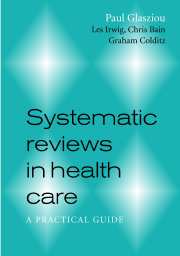Book contents
- Frontmatter
- Contents
- Acknowledgements
- Introduction
- Part 1 General methods
- 1 The question
- 2 Finding relevant studies
- 3 Appraising and selecting studies
- 4 Summarizing and synthesizing the studies
- 5 Applicability: returning to the question
- Part 2 Question-specific methods
- Appendixes
- Glossary
- Acronyms and abbreviations
- References
- Index
4 - Summarizing and synthesizing the studies
Published online by Cambridge University Press: 01 September 2009
- Frontmatter
- Contents
- Acknowledgements
- Introduction
- Part 1 General methods
- 1 The question
- 2 Finding relevant studies
- 3 Appraising and selecting studies
- 4 Summarizing and synthesizing the studies
- 5 Applicability: returning to the question
- Part 2 Question-specific methods
- Appendixes
- Glossary
- Acronyms and abbreviations
- References
- Index
Summary
Presenting the results of the studies (data extraction)
Tabular summary
It is helpful to produce tabular and graphical summaries of the results of each of the individual studies. An example of a summary table for an intervention question is shown in Part 2 of this book (Chapter 6, Table 6.1).
Graphical presentation
The most common and useful graphical presentation of the results of individual studies is a point estimate plot with the 95% confidence interval (CI) for each study (known as a ‘forest plot’). A value of less than 1.0 indicates that the intervention studied is beneficial. A forest plot can be done for the relative risk reduction or a specific measure such as reduction in blood pressure. Studies should be sorted from those with the broadest to those with the narrowest confidence interval. If there is a summary estimator, this should be nearest the studies with the narrowest confidence intervals.
In addition, because studies with broad confidence intervals draw greater visual attention, it is useful to indicate the contribution of the study visually by the size of the symbol at the summary estimate. The area of the symbol should be made proportional to the precision of the study (more specifically, to the inverse of the variance of the study's estimator). This means that the diameter of each symbol is proportional to the inverse of the standard error of the study's estimate. These principles are illustrated in Figure 4.1, which shows the results of the systematic review of colorectal cancer screening (Towler et al., 1998).
Information
- Type
- Chapter
- Information
- Systematic Reviews in Health CareA Practical Guide, pp. 32 - 44Publisher: Cambridge University PressPrint publication year: 2001
